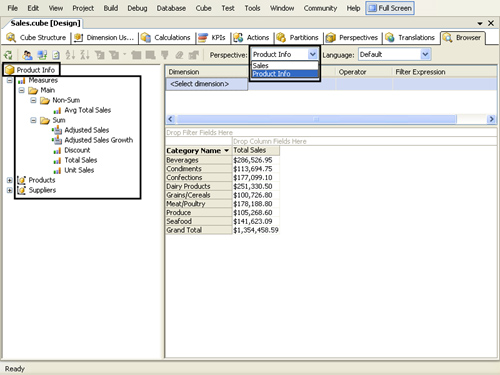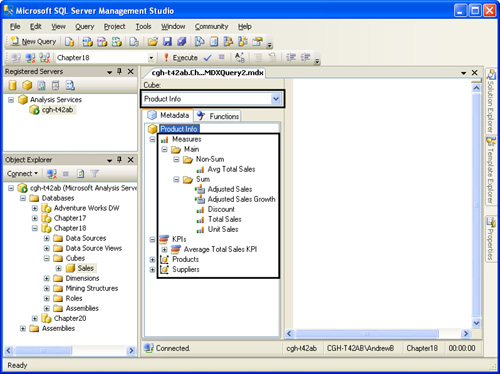One hallmark of Analysis Services 2005 is its flexibility and
accommodating nature. For example, the ability to have drillthrough
actions, role-playing dimensions, and multiple fact tables allows you to
use a single cube for a multitude of multidimensional and relational queries. With Analysis Services 2000, each fact table requires its
own cube, role-playing dimensions do not exist, drillthrough
functionality is much more limited, and the lack of proactive caching
means that cube data cannot be as fresh as is sometimes necessary.
This notion of a single cube acting as a one-stop
shop for all your dimensional data gives rise to an Analysis Services
2005 concept called the unified dimensional model
(UDM). The UDM paradigm advocates softening the distinction between
dimensional and relational data and promotes an outlook, if you will,
that a cube is more than just a cube. The UDM philosophy sees a properly
built Analysis Services 2005 cube as a comprehensive repository for all
aggregated and fact-level data.
That’s all well and good, but the UDM paradigm
causes an issue of its own: If you jam too much stuff into a single
cube, many of your users might become overwhelmed by the content of that
cube and therefore find it less useful. For this reason, Analysis
Services 2005 introduces the ability to create perspectives within your cubes.
Perspectives are simply filtered views of a
cube’s content. You define a perspective by picking a set of specific
measure groups (or specific measures), dimensions (or individual
attributes and hierarchies), calculations, KPIs, and actions for the
perspective and assigning it a name. Client applications treat
perspectives as if they are separate physical cubes. You can, for
example, combine sales, inventory, and HR information into a single
cube, and then publish each category of data as a separate perspective.
This gives you the simplicity and power of the UDM paradigm without
dispensing with the ability to deploy components of your dimensional
data as discrete units that appear as cubes in their own right.
Creating a perspective is easy. Simply click on
the Perspectives tab of the cube designer and click the New Perspective
toolbar button (second from the right), the Cube/New Perspective main
menu option, or the New Perspective shortcut menu option. Any of these
actions creates a new column on the Perspective tab’s grid. From there,
you enter the name of your perspective and then select all of the cube
objects you want to include. For now, create a new perspective called Product Info and assign it the entire Main measure group, the Products and Suppliers dimensions, the Average Total Sales KPI KPI, the Total Sales Drillthrough action, and the two calculated measures (Adjusted Sales and Adjusted Sales Growth).
Save and deploy your changes. In the cube
browser, first reconnect (you might have to do this more than once to
see the changes), and then notice that the Perspective drop-down list
now contains two items: Sales (the physical cube) and Product Info (the
perspective we just created). Select Product Info from the drop-down
list, and notice that in the metadata tree view only the cube’s measures
(including the two calculated measures) and the two dimensions we
selected when defining the perspective are listed, as shown in Figure 1.

Note also that the calculated measures are both
listed under the Sum display folder because the Calculation Properties
settings illustrated in Figure 6 were applied to the Sales cube, and they cascade through to the perspective as well.
In Management Studio, the
Object Explorer window enumerates only the physical cubes in an
Analysis Services database. However, the MDX query window lists the
perspectives in the Cubes drop-down list (and because the Product Info perspective precedes the Sales
cube alphabetically, the former will be selected by default). The
Metadata tab lists just the measures (including calculated measures),
dimensions, and KPIs, if any, that belong to the selected perspective or
cube, as shown in Figure 2.

Perspectives
provide an audience-targeted experience for your cubes, and they do so
through server-side configuration, easing the burden on application
developers. This notion of a server-enforced
customized view of a cube can be extended. For example, language
localization of the names of your cube’s objects and the cube’s contents
can be governed on the server as well. You can accomplish this by
creating Analysis Services 2005 translations. Also, enforcement, in the true sense of the word, is made possible by creating security roles
that include declaratively specified membership and cube object-level
permissions.